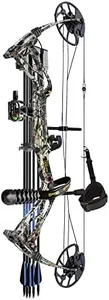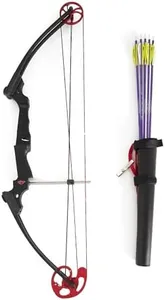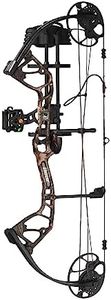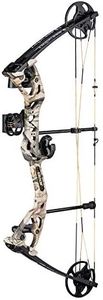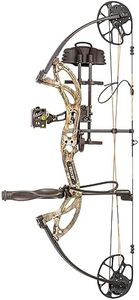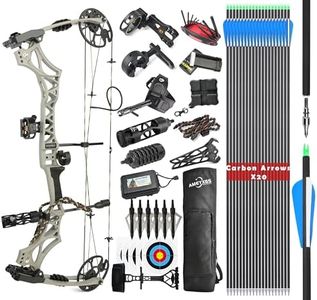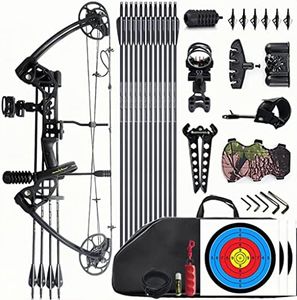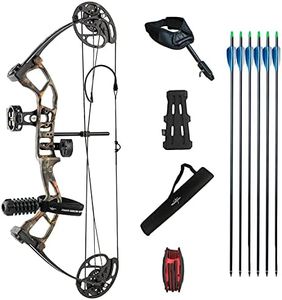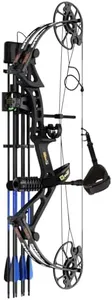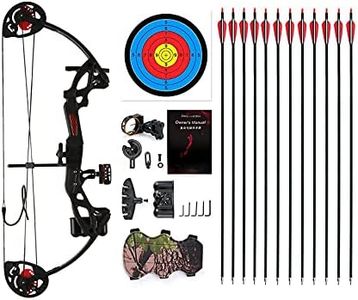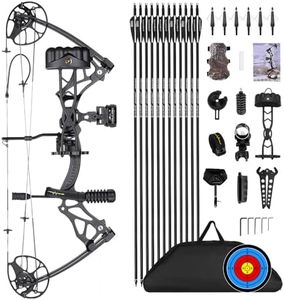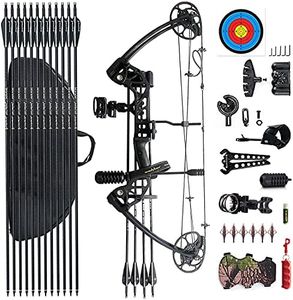10 Best Compound Bow Sets 2025 in the United States
Our technology thoroughly searches through the online shopping world, reviewing hundreds of sites. We then process and analyze this information, updating in real-time to bring you the latest top-rated products. This way, you always get the best and most current options available.

Our Top Picks
Winner
Sanlida Archery Dragon X8 RTH Compound Bow Package for Adults and Teens,18”-31” Draw Length,0-70 Lbs Weight,up to IBO 310 fps,No Press Needed,Limbs Made in USA,Limited Life-time Warranty
The Sanlida Archery Dragon X8 RTH Compound Bow Package offers a versatile and comprehensive solution for both adults and teens interested in archery. One of its major strengths is the wide range of adjustable draw lengths (18” to 31”) and draw weights (0 to 70 lbs), making it suitable for a variety of ages and skill levels. This flexibility means the bow can grow with the user, which is a significant advantage for beginners and intermediate archers.
The package is quite comprehensive, including essential accessories like a 5-pin sight, arrow rest, stabilizer, wrist sling, peep sight, arrows, quiver, release, arrow puller, bow stand, and a case, making it ready to use out of the box without the need for additional purchases. The bow's construction features high-quality materials, such as CNC machined cams and 6061 T6 aluminum, ensuring durability and performance. The IBO speed of up to 310 fps is decent, offering reliable performance for hunting and target practice. With an axle-to-axle length of 30” and a brace height of 6.6”, it strikes a balance between stability and maneuverability.
The bow's weight of 3.8 lbs is manageable, providing a good balance between sturdiness and ease of handling. Additionally, the no-press adjustment for draw weight and length adds convenience for users who may not have specialized tools. The lifetime warranty on main parts after registration provides peace of mind, although it requires timely registration. In summary, the Dragon X8 is a solid choice for those looking to start or advance in archery, offering great value with its adjustability, included accessories, and build quality.
Genesis Original Lightweight Archery Compound Bow and Arrow Set, Draw Hand - Right, Black
The Genesis Original Lightweight Archery Compound Bow is a fantastic choice for anyone looking to dive into the world of archery, especially beginners and users of all ages. Its adjustable draw length of 15-30 inches and weight range of 10-20 pounds make it suitable for a wide variety of skill levels and body types. This versatility is one of its primary strengths, making it accessible for both young archers and adults.
One of the highlights of this bow is its single cam design, which simplifies the shooting experience by reducing tuning issues and enhancing accuracy. This means less frustration for new users and more enjoyment in learning the sport. Additionally, the bow comes pre-assembled, so there’s no hassle setting it up right out of the box.
The included accessories, like the belt tube quiver and adjustable arm guard, add value to the package, ensuring you have what you need to get started immediately. With a solid construction featuring aluminum and composite materials, this bow is built to last while still being lightweight and easy to handle. However, there are some drawbacks to consider. Since this bow is primarily designed for right-handed users, left-handed individuals will miss out unless they can find a suitable alternative. The draw weight range may also be limiting for more advanced users who may prefer a heavier draw for greater performance. Lastly, while the bow is quite durable, it may not hold up as well under more rigorous professional use. The Genesis Original Compound Bow is an excellent choice for beginners and younger archers due to its user-friendly features, adjustable specifications, and solid construction. Those looking for a more advanced or left-handed option might want to explore further, but for entry-level archery, this bow delivers a great experience.
Bear Archery Royale Ready to Hunt Compound Bow Package for Adults and Youth, Right Hand, Break Up Country DNA
Most important from
458 reviews
The Bear Archery Royale Ready to Hunt Compound Bow Package is designed for both adults and youth, making it a versatile choice for a range of archers. One of its standout features is the adjustable draw length from 12 to 27 inches and peak draw weight from 5 to 50 lbs, accommodating various skill levels and physical sizes. Lightweight at just 2.7 lbs, this bow is easy to handle, which is beneficial for beginners and those who may spend long hours in the field.
This bow package comes fully equipped with essential accessories from Trophy Ridge and Fletcher Archery, including a sight, quiver, and whisker biscuit, ensuring you have what you need to get started right away. It boasts an impressive arrow speed of 290 feet per second, which adds to its appeal for those seeking efficient performance.
Despite its many advantages, there are a few drawbacks to consider. While the adjustable features are great for customization, they may require a bit of tinkering for those unfamiliar with bow setups. Additionally, as a right-handed bow, it may not be suitable for left-handed users, limiting its accessibility. The price point may also be a consideration for budget-conscious shoppers, although it is competitive within its category.
Most important from
458 reviews
Buying Guide for the Best Compound Bow Sets
Choosing the right compound bow set can be a rewarding experience, especially if you understand the key specifications that will best suit your needs. Whether you are a beginner or an experienced archer, knowing what to look for in a compound bow set will help you make an informed decision. Here are some important specifications to consider when selecting a compound bow set.FAQ
Most Popular Categories Right Now
